
Kirkcudbright is a town, parish and a Royal Burgh from 1455 in Kirkcudbrightshire, of which it is traditionally the county town, within Dumfries and Galloway, Scotland.

Crail ; Scottish Gaelic: Cathair Aile) is a former royal burgh, parish and community council area in the East Neuk of Fife, Scotland.

St Giles' Cathedral, or the High Kirk of Edinburgh, is a parish church of the Church of Scotland in the Old Town of Edinburgh. The current building was begun in the 14th century and extended until the early 16th century; significant alterations were undertaken in the 19th and 20th centuries, including the addition of the Thistle Chapel. St Giles' is closely associated with many events and figures in Scottish history, including John Knox, who served as the church's minister after the Scottish Reformation.
A steeple is a tall tower on a building, often topped by a spire.

Bathgate is a town in West Lothian, Scotland, 5 miles (8 km) west of Livingston and adjacent to the M8 motorway. Nearby towns are Armadale, Blackburn, Linlithgow, Livingston, West Calder and Whitburn. Situated 2 miles (3 km) south of the ancient Neolithic burial site at Cairnpapple Hill, Bathgate and the surrounding area show signs of habitation since about 3500 BC and the world's oldest known reptile fossil has been found in the town. By the 12th century, Bathgate was a small settlement, with a church at Kirkton and a castle south of the present day town centre. Local mines were established in the 17th century but the town remained small in size until the coming of the industrial revolution. By the Victorian era, Bathgate grew in prominence as an industrial and mining centre, principally associated with the coal and shale oil industries. By the early 20th century, much of the mining and heavy industry around the town had ceased and the town developed manufacturing industries, principally in vehicle production and later electronics before these factories closed in the late 20th century. Today Bathgate is the second largest town in West Lothian, after Livingston and serves as a regional commuter town within the Scottish Central Belt.
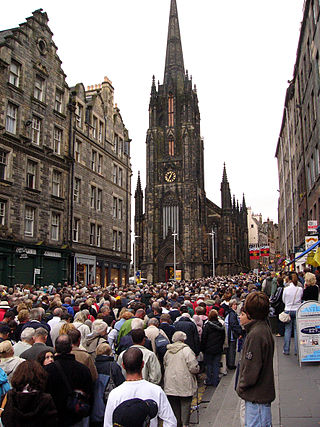
The Hub is a public arts and events building in the centre of Edinburgh, Scotland. Located at the top of the Royal Mile, it is a prominent landmark as its tall Gothic spire is the highest point in central Edinburgh, and towers over the surrounding buildings below Edinburgh Castle.

James Gillespie Graham was a Scottish architect, prominent in the early 19th century.

St Columba's Church is a Church of Scotland Parish church that used to serve a Gaelic congregation in Glasgow until its closure in 2021.
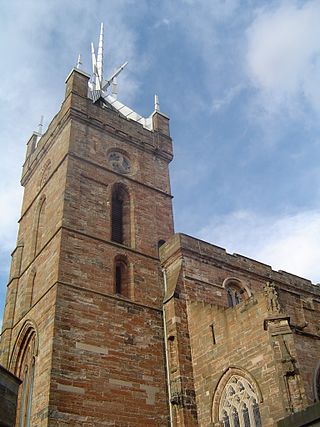
St. Michael's Parish Church is one of the largest burgh churches in the Church of Scotland. It is one of two parishes serving the West Lothian county town of Linlithgow, the other being St. Ninian's Craigmailen. St Michael is the town's patron saint; the town's motto is "St Michael is kinde to strangers".

Linlithgow is a town in West Lothian, Scotland. It was historically West Lothian's county town, reflected in the county's historical name of Linlithgowshire. An ancient town, it lies in the Central Belt on a historic route between Edinburgh and Falkirk beside Linlithgow Loch. The town is situated approximately 20 miles (32 km) west of Edinburgh.

Torphichen is a historic small village located north of Bathgate in West Lothian, Scotland. The village is approximately 18 miles (29 km) west of Edinburgh, 7 miles (11 km) south-east of Falkirk and 4 miles (6.4 km) south-west of Linlithgow. The village had a population of 570 in the and a population of 710 in 2016. Torphichen's placename may be Gaelic in origin, e.g., "Tóir Féichín", Tor Fithichean, or partly from Brythonic "tre fychan" or small hill.

South Leith Parish Church, originally the Kirk of Our Lady, St Mary, is a congregation of the Church of Scotland. It is the principal church and congregation in Leith, in Edinburgh. Its kirkyard is the burial place for John Home and John Pew, the man from whom the author Robert Louis Stevenson reputedly derived the character of Blind Pew in the novel Treasure Island. The church has been repaired, used as an ammunition store and reconstructed but still retains the basic layout of the nave of the old church.
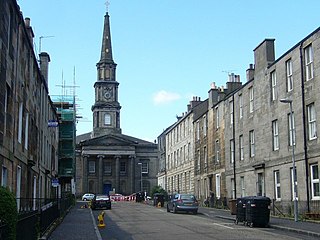
North Leith Parish Church is a congregation of the Church of Scotland, within the Presbytery of Edinburgh. It serves part of Leith, formerly an independent burgh and since 1920 a part of the city of Edinburgh, Scotland.

Matthew Edward Habershon, known as Edward Habershon, was an architect practising in London and south-east England. He specialised in neo-gothic buildings, especially churches and chapels. With his brother W.G. Habershon he designed St John the Baptist's Church, Hove, now a Grade II building. With E.P.L. Brock he designed a number of churches including St Leonards-on-Sea Congregational Church, also listed at Grade II. He designed St Andrews church in Hastings, where Robert Tressell's large mural was created. In 1862 he was involved in the relocation of London's burial grounds, moving more than one thousand hundredweight of human remains.
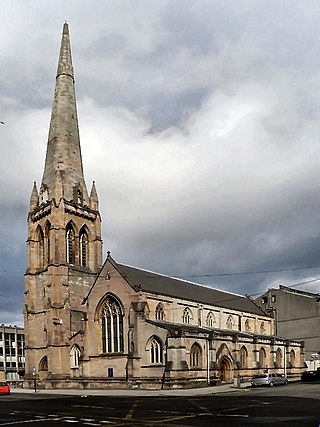
St Andrew's West, formerly but more commonly known as Renfield St Stephen's, is a Church of Scotland parish church in Glasgow. It was designated a Category B listed building in 1970.
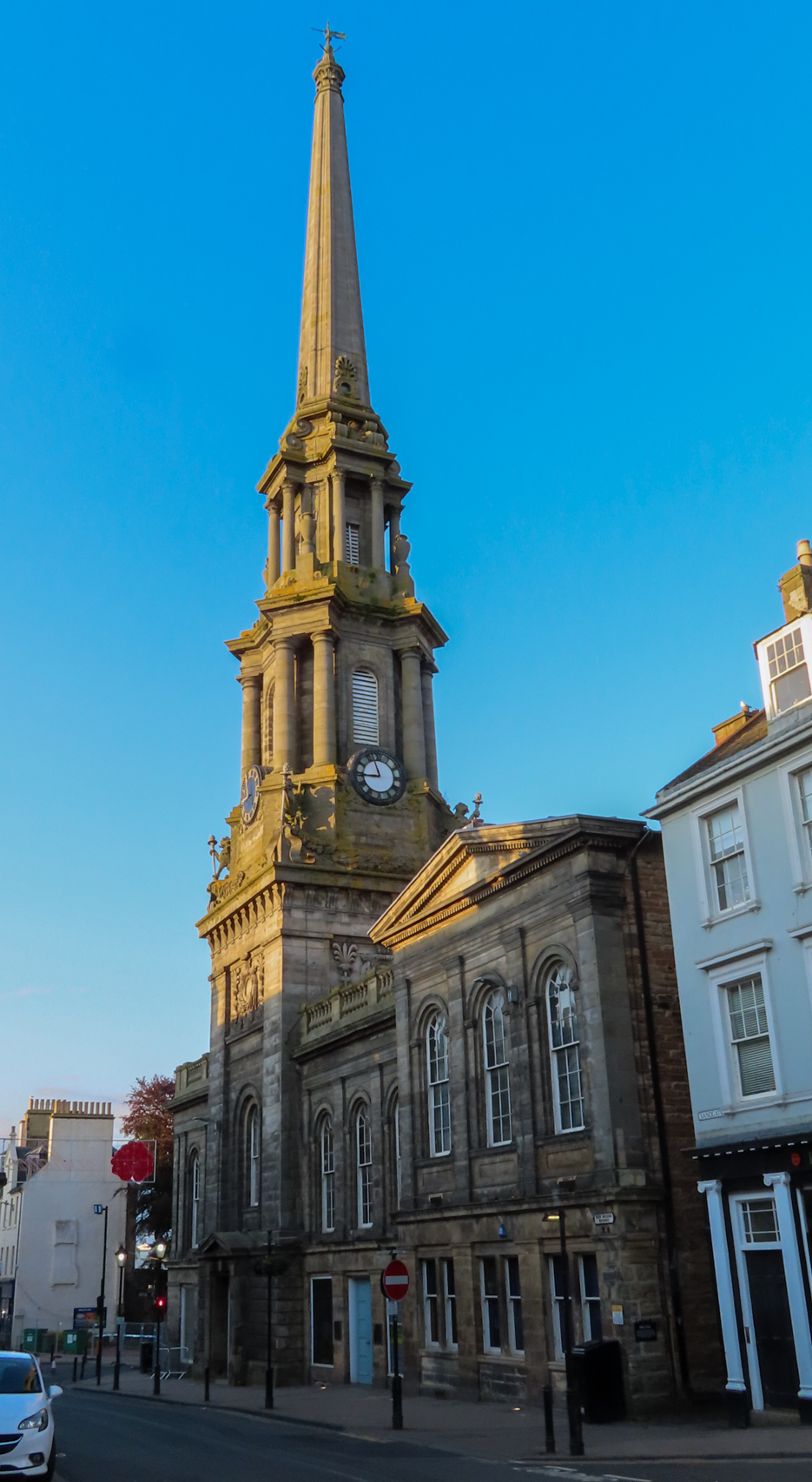
Ayr Town Hall is a municipal building in New Bridge Street, Ayr, Scotland. The town hall, which was the headquarters of Ayr Burgh Council, is a Category A listed building.

The Glasgow Tolbooth was a municipal structure at Glasgow Cross, Glasgow, Scotland. The main block, which was the meeting place of the Royal Burgh of Glasgow, was demolished in 1921 leaving only the steeple standing. The steeple is a Category A listed building.

West St Giles' Parish Church was a parish church of the Church of Scotland and a burgh church of Edinburgh, Scotland. Occupying the Haddo's Hole division of St Giles' from 1699, the church was then based in Marchmont between 1883 and its closure in 1972.

Pittenweem Parish Church and Tolbooth Steeple is an ecclesiastical and municipal complex in the High Street, Pittenweem, Fife, Scotland. The structure, which is used as the local parish church, is a Category A listed building.





















